Physical Address
304 North Cardinal St.
Dorchester Center, MA 02124
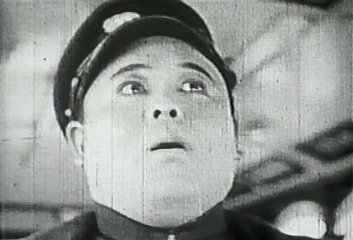
Alternative titles: Heaven Day Return, Heaven Day Trip (literal English titles)
| Production Company | Nikkatsu Uzumasa (Taiso) |
| Scenarist | Kobayashi Masashi1 |
| Cinematographer | Matsuzawa Matao |
| Performers | Tamura Kunio (Asahina Takuhachi, a bus driver); Sakuma Taeko (Kawai Kimiko); Mine Ginko (Kinoshita Akako); Miake Bontarō (Sarumaru Sanshirō); Sugai Ichirō (Kuzuhara)2 |
| Status | About 20 percent extant (see Commentary and Analysis below) |
| Photography | Black and white |
| Original Format | 9.5mm (see Commentary and Analysis below) |
| Sound | No |
| English Subtitles | No (unsubtitled Japanese intertitles) |
| Original Release Date | July 25, 1930 |
| Length | Currently: approx. 10 minutes (DVD version); originally: 1462 meters (see Commentary and Analysis below) |
(Note: This very short film exists in far too fragmentary a state for a plot synopsis; therefore, we will only briefly summarize the surviving scenes.)
A very fat bus driver, Asahina Takuhachi, spots in his rear-view mirror a passenger, the “modern girl” Akako (apparently his own girl), sitting next to a shifty-looking, sharp-dressed man. Takuhachi himself is chatting with a second, similarly-dressed modern girl, Kimiko, standing beside the driver’s seat. In a flashback, he recalls a time when Akako put a cotton swab in his ear, apparently to treat an infection. Distraught and distracted, he almost crashes the bus.
At an outdoor festival, a lottery takes place. Takuhachi, obliviously eating the picnic food, doesn’t realize that he’s won until a passerby points out that he has the winning ticket. He runs to the stage and everyone congratulates him. He then goes to a restaurant to eat an expensive meal.
Back on the bus, with Takuhachi again driving, Kimiko receives a newspaper from a male passenger and shows this to Takuhachi, who, after raising his arms in glee, turns the bus around the way it had come and soon loses control of the vehicle, ultimately driving it back to the bus garage.
Takuhachi is sitting in a restaurant with both the sharp-dressed man and Akako. He looks somewhat anxious until the man hands him a large pile of money. Several other well-dressed businessmen consult a chart. They look as if they’re trying to talk the hero into some kind of scheme, with the woman’s help.
In the bus parking lot, the hero happily talks to his friends (co-workers?), while showing them a document, but they all abandon him, except for one other man and Kimiko. Apparently, he has just received news he doesn’t like, for he leaves in a rage.
Takuhachi runs into an office and angrily confronts the well-dressed men from the restaurant, threatening them with a chair. They show him a piece of paper that apparently changes his mind.
At a restaurant, one of the sharp-dressed men talks to a group of men around a table, while Takuhachi looks downcast. A little while later, however, he appears happier… and much drunker.
Still in the restaurant, the drunken Takuhachi is being entertained by geisha when he suddenly begins to perform a dance (with a kerchief wrapped around his head, as if he has a toothache) and eventually he collapses, dazed. The geisha bring him out onto a balcony where the still-drunken Takuhachi sees a building burning in the distance.
The next morning Takuhachi drives with the geisha to the building site and realizes to his horror, as the women comfort him, that the building that burned down is his. He gets out of the car and inspects the wreckage, looking heartbroken. Some men arrive to talk to him.
He then runs through the city streets with another man who is wearing pajamas. He reaches the office where he is greeted by a group of bewildered-looking office workers. The sharp-dressed men are nowhere to be found.
He has returned to the site of the ruined building. He is seated and leaning on his cane, utterly dejected. Kimiko arrives with some police and he tries to run away, but the girl, smiling, stops him.
Takuhachi is last seen in a car, apparently a taxi, and as he smiles Kimiko places on his head a taxi driver’s cap. He drives away.
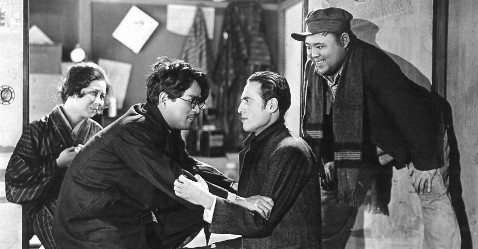
Tamura Kunio was a heavy-set Japanese character actor. For Uchida, in addition to this film, he was cast as a laborer in the extant Sweat (Kigeki Ase, 1929), and also appeared in the lost films The Way of the Corrupt World (Shaba no kaze, 1929) and the critically-acclaimed The Revenge Champion (Adauchi senshu, 1931). He performed in one of the first part-talking pictures ever made in Japan (and the earliest-surviving such film): Fujiwara Yoshie’s Hometown, a.k.a., Hometown (Fujiwara Yoshie no furusato, 1930), directed by Mizoguchi Kenji, which was apparently inspired by the American film, The Jazz Singer (Alan Crosland, 1927). Tamura’s most famous film was also one that Mizoguchi directed: Osaka Elegy (Naniwa erejī, 1936), in which he portrayed a meddlesome doctor. He died in February 1941 in the Japanese-occupied province of Shanxi in North China, at the age of 33.
(Note: Of all the Uchida films for which I own a copy, this one is in the poorest condition, in a heavily-damaged print with many missing frames, and this is reflected in the wretched quality of the screenshots below.)
I’ve included a review of this ten-minute film on my blog mainly for the sake of completeness. When I first saw this movie, it seemed merely a senseless jumble of images, but on repeated viewings, the semblance of a recognizable plot gradually took shape. However, the nuances of that plot and of the characterizations remain obscure to me, owing to the incomplete nature of the print and my own very rudimentary knowledge of the Japanese written language, which made all but the simplest intertitles unreadable for me.3
The length of the version of the film released in 1930, according to my source, was about 1450 meters, which would have made its running time only slightly shorter than the approximately 50-minute running time of the previous year’s Uchida comedy, Sweat. If this information is accurate, the length of the version now available on DVD would therefore represent somewhere between 20 and 25 percent of the original.
This is borne out by the many apparent ellipses and abrupt edits, indicating a great deal of missing footage. For example, in the second restaurant scene, the hapless hero is at first shown seated with a group of men around a low table, then, without transition, is shown drunkenly dancing for a crowd of geisha and finally, again without transition, is shown standing, very drunk, on the balcony while watching a building burn in the distance.
The format in which this film was originally distributed, as well as the story of its relatively recent discovery, are both worth noting. During the silent era, a new film format, 9.5mm, was produced by the major French film company Pathé (the company still, of course, exists today) to be marketed to amateur film exhibitors. The system was called “Pathé Baby” and this unusual film format was distinguished by a series of single perforations (sprocket holes) down the middle of each frame, instead of double perforations on each side, as is the case with 16mm, 35mm and other formats. This system allowed the image to be printed over the entire width of the frame, as opposed to the other formats, for which parts of the frame necessarily did not include any of the image because of the sprocket holes on the sides.
Return to Heaven was distributed, at least in some areas of Japan, in the 9.5mm format. This movie, and others like it, seem to have been particularly popular in rural areas. In one such area, Minami-Uonuma, a tiny district in Niigata prefecture in northwestern Japan, a collection of about 30 old films was discovered in 1995. It belonged to a man named Ukayama, a Shinto priest who raided Tokyo department stores to purchase Pathé Baby prints, which he would then project for a local audience at his shrine. When a film scholar found out about this, she asked Ukayama to send her a list of the titles in his collection, and discovered to her astonishment several silent films long considered lost – including, in addition to this film, Ozu Yasujirō’s Fighting Friends, Japanese-Style (Wasei kenka tomodachi, 1929), now the second-oldest extant Ozu film. The fascinating story of the discovery of these films is related on the Film Preservation Society’s (FPS) website.
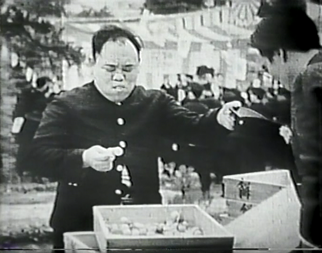
The plot of Return to Heaven appears to be similar to that of Uchida’s lost A Living Puppet (Ikeru ningyō, 1929) of the previous year, except that this film’s protagonist is not, like the earlier one, an ambitious con man, but a simple working-class fellow, a bus driver who wins a fortune in a lottery and who’s apparently exploited because of this fact. Since this was the era of the keikō eiga (“left-tendency”) film, it stands to reason that Uchida would portray a member of the proletariat sympathetically. And in fact this film has a happy ending of sorts, as the humble hero, having apparently lost all his wealth, cheerfully starts a new career as a taxi driver.
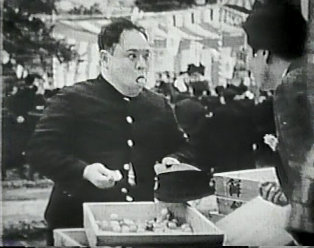
The lead actor, Tamura Kunio, is strongly reminiscent of the Hollywood comedian Roscoe “Fatty” Arbuckle, both in his girth and his exaggerated, physically agile responses to those around him. (Tamura’s extremely mobile face makes him the diametrical opposite of a deadpan comedian like Buster Keaton.) Very typical is the actor’s behavior during the lottery scene. As the winning ticket number is called, the crowd gathers to see who the fortunate ticket holder is – all except Takuhachi, who has taken the opportunity to raid the picnic table. With his hands and mouth full of food, the bus driver is asked by a bystander to show the ticket he had bought, since no one had so far claimed the prize. Since he had stowed the ticket in the band of his cap, Takuhachi wordlessly doffs it and shows it to the man, who identifies the ticket as the winning one.
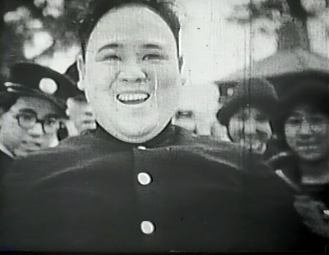
Tamura then acts exactly as the athletic but childlike Arbuckle would have done in the same situation. He jumps up and down, waving his arms about frantically, and then runs towards the stage to claim his victory. The only difference is that, when he gets there, the character enthusiastically and repeatedly bows, in very Japanese fashion, before the contest judges to express his gratitude.
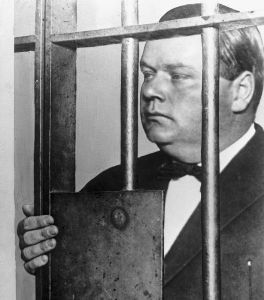
The apparent imitation of Arbuckle is quite moving, as that comedian had been banned from the screen since the summer of 1921, when he was arrested for murder in the death of the actress Virginia Rappe. Though eventually acquitted, Arbuckle never appeared onscreen again, except for a series of minor Warner Brothers shorts released in 1933, the year of his death. So by 1930 it had presumably been years since the Japanese audience had seen an Arbuckle film, yet a young Japanese actor still saw fit to evoke his comedic style in a new film.
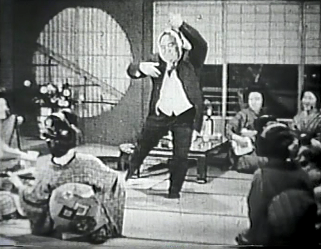
The most amusing scene is undoubtedly the drunken dance – which looks like a geisha’s dance – that Takuhachi performs in front of the geisha. Somewhat ironically, this is the most theatrical scene in the movie as it now exists. Uchida here abandons the fast editing and montage-based construction typical of the other scenes, and simply shoots it straight, letting Tamura perform his charming routine in real time without cutting.
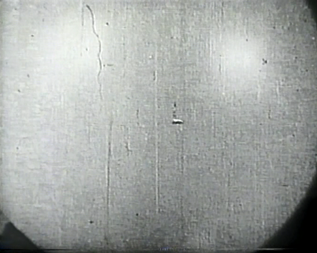
Speaking of montage, there’s an interesting, completely extraneous image that appears in the middle of the movie showing the hero blowing up a balloon, apparently intended to symbolize his growing hopes for whatever scheme the con artists have convinced him to support. When he sees that the building has burned down, this balloon suddenly bursts.
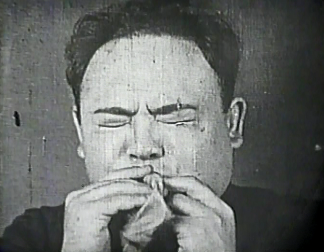
Such a startling visual metaphor reminds me of Soviet films, particularly the kind of thing Eisenstein did in October (Oktyabr, 1927). A strong Soviet influence wouldn’t be surprising in Uchida’s case, since he would later teach Eisenstein’s and Pudovkin’s editing theories to Chinese and North Korean filmmakers during his eight-year sojourn in China.
Although I’ve rated other incomplete or even mutilated Uchida works (e.g., Crown of Life, Earth, Unending Advance), this film is in far too fragmentary a state to be properly rated. (It should be noted that no one else on IMDb has rated the film either.) However, the plot and the protagonist seem interesting, so though the movie would surely never have been better than a minor comedy even if complete, it’s still to be regretted that the film in its entirety is unavailable.
Film Preservation Society (FPS): Silent Film: Discover, Restore, Preserve then Show! (Part One) – Story of the discovery of the collection of silent films in which this movie was discovered, as well as a detailed description of the 9.5mm (Pathé Baby) film format.
Japanese Movie Data Base (jmdb) – Credits for the film (translated to English via Google)